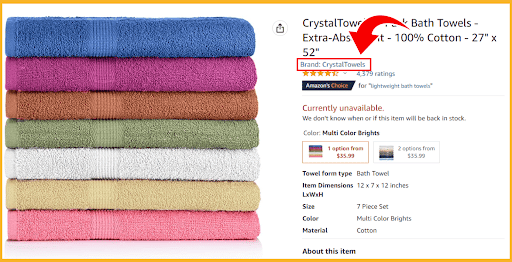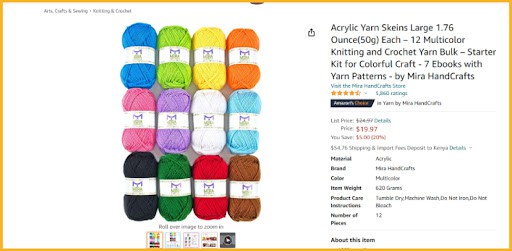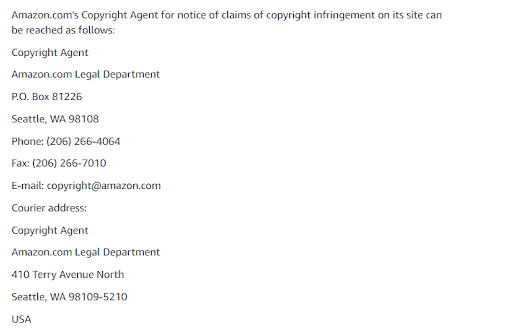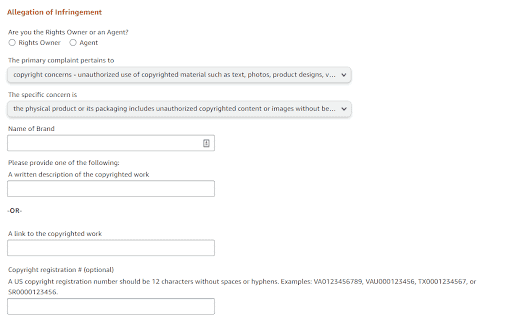Amazon is one of the most popular ecommerce platform. With over 12 million products for sale, it’s no wonder why so many people flock to Amazon to find what they need.
But with this large selection of products also comes a high risk for copyright infringement – which is no laughing matter.
Do you have any idea what copyright infringement is? If not, then let this post be your guide.
We will discuss what Amazon copyright infringement is, how to report copyright infringement, how to appeal one, and how to remove a copyright strike on Amazon.
I will also provide some tips on how to avoid infringing on someone else’s copyrighted material.
Let’s get started!
What is an Amazon Copyright Infringement?
Copyright infringement is the prohibited or unauthorized use of copyrighted material. This can include using someone else’s copyrighted work without their permission or using copyrighted material in a way that violates the copyright owner’s intellectual property rights.
Copyright infringement can also occur when someone tries to sell, distribute, or profit from a copyrighted work without the copyright owner’s permission.
So how can it happen on Amazon? There are a few possible ways
One way is by listing copyrighted products for sale without the copyright owner’s permission. This includes listing counterfeit items or selling unauthorized copies of copyrighted works.
Another way someone can infringe on another’s copyright is by using copyrighted images or videos without the copyright owner’s permission.
An example would be uploading these materials to Amazon without the consent of the copyright owner, or by using them in Amazon listings without attributing the rightful owner. An Amazon copywriter can help you create listings in the right way.
Copyright infringement can have severe consequences for those who are found guilty of infringing on someone else’s copyright.
Amazon could remove your listings, suspend your account, or even ban you from selling on their platform.
You could also be subject to legal action from the copyright owner. This could include a lawsuit or settlement, and you may also be liable for damages.
Intellectual Property Protection on Amazon
There are four main types of intellectual property: trademarks, copyrights, patents, parallel imports, and right of publicity.
Trademarks are words, phrases, logos, or other symbols that identify a brand or product. Trademark infringement involves using these elements without permission from the brand owner. Product and brand names are frequently displayed on Amazon’s product detail pages as trademarks, as shown in the example below:

Patents are inventions or processes that are given legal protection. Examples of patents include a new type of product, a new way of manufacturing something, or a new method of doing business.
Copyrights are original works of authorship, such as books, music, and artwork.
For example, the owner of Mira Handcrafts took the photos of the crochet yarn pictured below and owns the copyright to the images.
If a seller copies these images to sell their product on a different product detail page, the seller may be infringing on the yarn images’ copyright, and this will be a copyright violation.

Copyright violations on Amazon can happen in different stages. These include:
- ASIN-Level (ASIN stands for Amazon Standard Identification Number) – This is the most common type of infringement. It happens when a seller or sellers uses your image or text on a patented product or packaging without your permission.
- Image or Text – This is when someone uses your image or text on an existing listing or product details page. For example, if you find your image or text in their product description or on product listings.
- Seller-level – This happens when an offer from a seller’s listing infringes your copyright. Take this example: Beige Thomson is the owner of Crochet by Paige, and she creates original crochet patterns. One day she notices that another seller, “Amy M,” is selling a digital copy of her copyrighted pattern on Amazon. Even though Amy M did not create the pattern, she is still infringing on Paige’s copyright.
Parallel imports are products that are imported from another country without the permission of the intellectual property owner. An example of parallel imports is if someone buys products in another country, such as Canada, and then resells them on Amazon.com in the United States without the permission of the intellectual property owner. This would be an intellectual property rights infringement.
Right of publicity is the right to control the use of your name, image, or likeness. An example of infringement of right of publicity would be if someone uses your name or image to sell a product without your permission.
On Amazon, copyright and trademark infringements are the two types often committed on the ecommerce platform.
How To Report Amazon Copyright Infringement
If you believe that someone has violated your copyright on Amazon, you can report the Amazon seller copyright infringement by:
1 – Using the RAV (Report a Violation) tool: If a business is registered with the Amazon Brand Registry, they can use the RAV tool to report any copyright violation or IP violations directly. The RAV tool is an Amazon-provided general program that allows sellers to report any form of infringement.

2 – Emailing or writing to Amazon’s copyright department: Address your email to copyright@amazon.com, or send a letter to the copyright agent using the details in the picture below.
Be sure to include all relevant information in your email, such as links to the infringing listing or product detail page, and your contact information.

3 – Filling up the Report Infringement form: If you’re not registered with the Brand Registry, you can fill out the Report Infringement form. Once you’ve completed the form on copyright infringements, you’ll need to submit it to Amazon along with your evidence. Amazon will then review it and take appropriate action. Here’s how the form looks like:

The following information should be included in your report for all the three ways of reporting copyright infringement:
- The exact IP rights that you claim have been infringed. Use identification numbers for patents, copyrights, or trademarks to help them expedite your claim.
- A description of where the infringing material is located on the Amazon site, including as much detail as possible. You’ll need to gather evidence that the Amazon seller is infringing on your copyright. This can include screenshots or images of the infringing product, the listing URL or product ID as well as any other relevant documentation.
- Your contact information so that Amazon can send you a confirmation when they receive your report, and follow up with you if necessary. This may include your phone number, physical address, and email address.
- A statement by you that you have a good faith belief that the use of the material in the manner complained of is not authorized by the IP owner, its agent, or the copyright laws.
- A statement by you, made under penalty of perjury, that all of the information provided in your report is accurate and that you are the IP owner or are authorized to act on behalf of the IP owner.
- Your physical or electronic signature.
After you’ve submitted your report, Amazon will review it and take appropriate action. This may include removing the infringing material or suspending the offender’s Amazon account.
How To Appeal Amazon Copyright Infringement
Receiving a copyright infringement notice is no laughing matter.
But don’t panic if you do get one, because the Amazon marketplace gives you the opportunity to appeal the notice and have your account reinstated.

Here’s what you need to do:
Step 1:
Check the notice if it is valid. This includes looking at the content in question and confirming that it is your original work. It will also help to learn about the Amazon Intellectual Property Policy. This will help you determine whether you may have infringed on someone else’s copyright.
Step 2:
Come up with a Plan of Action to respond to the patent infringement notice. Describe the problem, the remedies, and the approaches you’re willing to take to solve it.
Step 3:
Submit your Plan of Action to Amazon. Include as many details as possible and be sure to backup your Amazon copyright infringement claims with evidence.
This may include screenshots or images of the infringing product and the listing URL or product ID. This helps prove your case with Amazon and it saves time spent looking into your claim, which shortens the amount of time spent.
If you follow these steps, you should be able to get your account reinstated soon. Amazon marketplace takes these claims seriously, so it is important that you do as well.
Also, PSA: Amazon only considers three to four responses to a single appeal. Consequently, So better make sure your responses are focused on quickly solving the problem.
Do not try to open another seller account if your original account has been suspended and has no selling privileges. This will only result in more problems down the road like being permanently banned from selling on Amazon. If you believe that the copyright infringement notice was issued in error, it is better to appeal it and have it resolved.
How to File an Amazon Trademark Infringement Appeal
If you’re selling a product that is similar to another company’s trademarked product, you may receive an intellectual property infringement notice from Amazon.
This usually happens when a company feels that your same product is too similar to their own and that it could cause confusion among customers.

Here are steps to appeal an Amazon trademark and patent infringement claim:
Step 1:
Gather all evidence that shows your product is not infringing on the other company’s trademark. This could include things like sales data, marketing materials, and customer feedback.
Step 2:
Write a clear and concise appeal letter that proves why you’re wrongfully accused of committing infringement. Be sure to include all of the evidence you have gathered.
Step 3:
Send your Amazon copyright infringement appeal letter to Amazon’s Trademark Infringement Department.
Step 4:
Amazon will review your appeal and make a decision. If they find that you indeed did not commit a violation, the infringement claim will be removed from your account and you’ll be able to continue selling the product in question.
However, if they confirm that you did commit a violation, you may be required to remove the listing from your account or risk having your account suspended.
How To Remove a Copyright Strike on Amazon
A copyright strike is when Amazon receives a complaint from someone claiming that you’ve infringed on their copyrighted material.
If Amazon finds that the complaint is valid, they’ll issue a copyright strike against your account.
Your account may be suspended because of a copyright strike – which you wouldn’t want to happen, right?

Here’s a step-by-step guide on how to remove a copyright strike on Amazon.
Step 1:
Contact the person who filed the complaint and ask them to retract it. If they agree, they’ll need to fill out a retraction form and send it to Amazon.
Step 2:
1 – If the person who filed the complaint doesn’t want to retract it, you can try to resolve the issue with them directly. If you can come to an agreement, make sure to get it in writing and forward it to Amazon.
2 – If you’re unable to resolve the issue with the person who filed the complaint, you can file a counter-notice with Amazon. To do this, you’ll need to fill out a form and send it to Amazon’s copyright department.
Step 3:
Once Amazon receives your counter-notice, they’ll contact the person who filed the complaint and let them know that you’ve disputed their claim.
The person will then have time to respond if they want to pursue the matter further.
If you don’t hear anything from the person who filed the complaint after this period, congrats!
The copyright strike will be removed from your account and you can go back to selling on Amazon like normal. Optimize your listings and you’ll be on your way to making sales again.
How to Avoid Copyright Infringement on Amazon
Prevention is better than cure, as the saying goes. So how can you avoid copyright infringement on Amazon? Here are a few tips:
- Do your research. Before listing a product on Amazon, make sure you have the right to sell it. This means ensuring that you have the proper licenses and permissions from the copyright holder. An Amazon copywriter can help you create a proper listing.
- Avoid using someone else’s copyrighted material in your own listing. This includes things like copyrighted images, descriptions, and even reviews. If you’re not sure whether something is copyrighted, you may be better of not using it.

Source: Unsplash.com
- If you’re selling a used product, make sure you have the right to do so. Many copyrighted products, such as books, DVDs, and video games, can only be resold if they are part of a larger collection (e.g., a used book store).
- Learn about Amazon infringement policies. Amazon has a number of policies in place to deal with intellectual property infringement, and it’s important that you understand them. This way, you can avoid intellectual property violations on Amazon.
FAQ – Frequently Asked Questions
How do I write a complaint to a trademark on Amazon?
If you want to file a notice of infringement, go to Amazon’s Report Infringement form and fill it out. It is designed for intellectual property rights owners and their agents to inform Amazon of presumed intellectual property infringements including trademark infringement issues and copyright concerns.
Can you sue Amazon for copyright infringement?
It is possible to sue Amazon for copyright infringement, but it’s important to understand that Amazon is not liable for the infringing actions of its users. This means that you would need to sue the one seller who is infringing on your copyright, not Amazon.
Is Amazon liable for copyright infringement?
No, Amazon is not liable for copyright infringement. This means that the party liable would be the individual seller who is infringing on your copyright, not Amazon. However, they are required by law to remove infringing material from their platform when they are notified of the matter.
The Bottom Line
Now that you’ve finished this guide on Amazon copyright infringement, you can protect your business from getting a copyright strike or from sellers who may be infringing on your copyrights.
As we’ve discussed, there are a number of ways to protect your work and avoid infringing on someone else’s copyright.
If you take the time to understand the ins and outs of Amazon’s copyright policies, running your business will be smooth sailing 🙂






